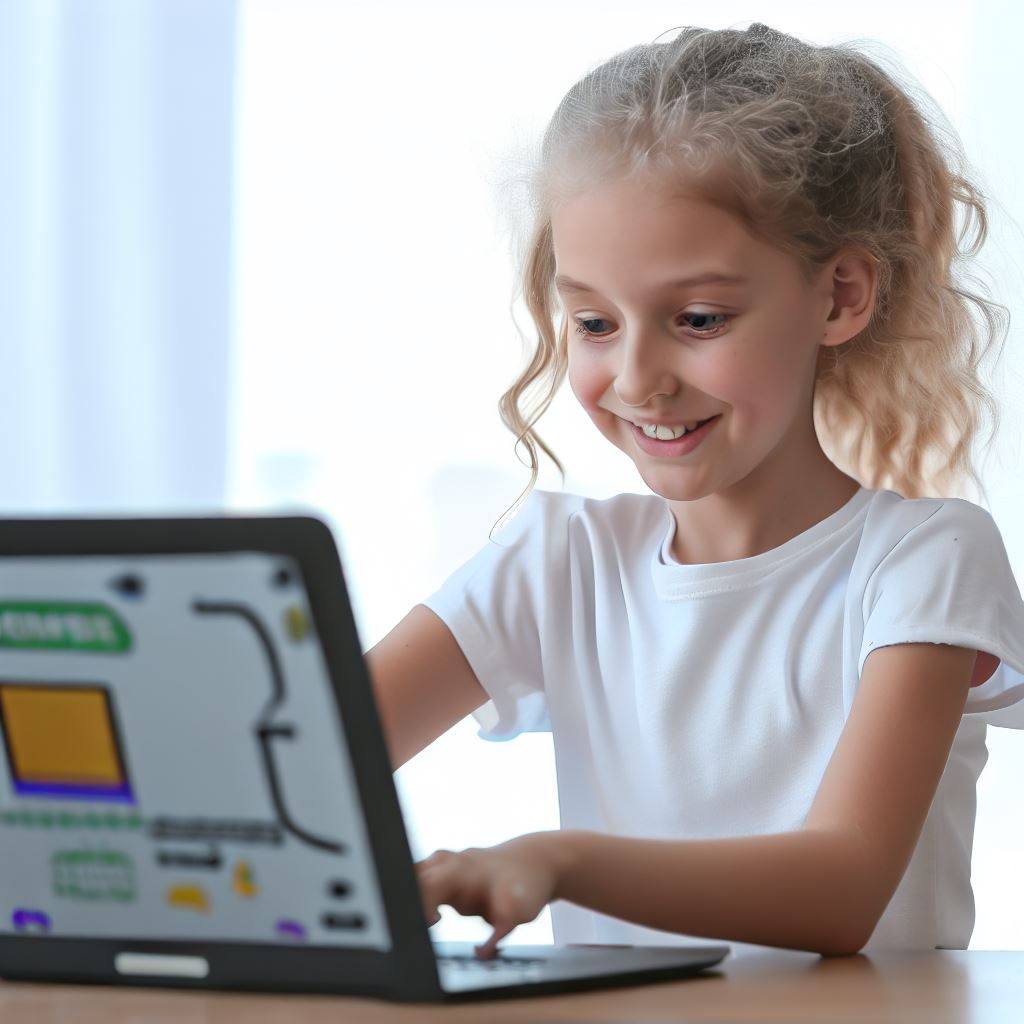Building Interactive Stories in Scratch: A Step-by-Step Guide.
Last Updated on September 24, 2023
Introduction to Interactive Stories in Scratch
Interactive stories in Scratch allow users to create engaging and dynamic narratives using coding.
These stories involve user interaction, where the user can affect the storyline’s progression.
They are important as they enhance user engagement and creativity while developing problem-solving and storytelling skills.
Scratch, a visual programming language, offers a user-friendly interface and a wide range of capabilities for building interactive stories.
With Scratch, users can design characters, animate them, create dialogues, add sound effects, and develop decision-based narratives.
The drag-and-drop programming blocks in Scratch make it accessible for beginners to code interactive stories.
Furthermore, Scratch provides a platform for sharing and remixing projects, encouraging collaboration and inspiration.
The interactive nature of these stories increases user motivation, as they become active participants in the storytelling process.
Developing interactive stories in Scratch promotes computational thinking, logical reasoning, and creativity in a fun and engaging way.
Understanding the Structure of Interactive Stories
- A well-developed story consists of characters, plot, and setting.
- Characters bring the story to life by engaging the audience.
- A captivating plot keeps the audience interested and eager to explore further.
- The setting provides a backdrop for the story, creating a sense of time and place.
- Interactive stories allow users to actively participate and influence the outcome.
A. Elements of a well-developed story
- Characters: Imaginative and relatable characters help users form emotional connections.
- Plot: An engaging sequence of events that follows a logical structure and builds suspense.
- Setting: A richly detailed environment that enhances the overall storytelling experience.
B. The role of decision-making in interactive stories
- Decision-making empowers users to shape the storyline based on their choices.
- Users become active participants and feel a sense of control over the narrative.
- Decisions create branching paths, allowing for different story outcomes and experiences.
- Choices with consequences add depth and make the story more immersive and impactful.
- Decision-making encourages critical thinking and problem-solving skills among users.
C. Incorporating branching paths and multiple endings
- Branching paths offer users diverse options to explore and shape the story’s direction.
- Each decision leads to a different consequence, altering the course of the narrative.
- Multiple endings provide a sense of closure and reward users for their active involvement.
- Endings can be based on the accumulated choices throughout the interactive story.
- Different endings add replayability and encourage users to explore various story possibilities.
Read: The Evolution of Coding Hours in the Past Decade
Planning Your Interactive Story
In this section, we will discuss the first step in building interactive stories in Scratch: planning.
Planning is a crucial process that helps you define the main plot, create engaging characters with unique personalities, and design the setting with interactive elements.
Let’s dive in!
A. Defining the main plot and theme
- Start by brainstorming ideas for your story’s plot. Think about what kind of story you want to tell and what message or theme you want to convey.
- Once you have a general idea, narrow down your plot and focus on the main conflict or challenge your characters will face. This will give your story a clear direction.
- Consider adding twists or unexpected events to make your story more interesting and engaging for the audience.
B. Creating engaging characters and their personalities
- Think about the role each character will play in your story. Are they the protagonist, antagonist, or supporting characters? Define their goals and motivations.
- Give each character a unique personality by considering their background, traits, and quirks. This will make them relatable and memorable for the audience.
- Create character arcs by thinking about how your characters will change and grow throughout the story. This adds depth and complexity to their development.
C. Designing the setting and determining its interactive elements
- Visualize the world where your story takes place. Think about the time period, location, and any unique features that make it interesting.
- Consider how you can make the setting interactive. Are there objects or elements that characters can interact with, such as doors, buttons, or hidden items?
- Use Scratch’s programming tools to incorporate interactive elements into your story. For example, you can use conditional statements to make different choices lead to different outcomes.
Planning is an essential step in building interactive stories in Scratch.
By defining the main plot and theme, creating engaging characters, and designing the setting with interactive elements, you lay a solid foundation for a captivating and immersive storytelling experience.
So, take your time to plan and unleash your creativity in the world of interactive stories!
Read: Studies on Optimal Coding Hours for Maximum Efficiency
Building the Framework in Scratch
A. Introduction to Scratch’s interface for creating interactive stories
Scratch is a visual programming language that allows users to create their own interactive stories, games, and animations.
In this step of our guide, we will explore Scratch’s interface and how to use it to build interactive stories.
B. Using sprites and backdrops to set up scenes
In Scratch, sprites are the characters or objects that interact with the user.
Backdrops are the backgrounds that set the scene for the story. To create an interactive story, we need to use sprites and backdrops effectively.
To add a sprite, click on the “Choose a sprite from library” button in the sprite pane. This will open a library of pre-designed sprites that you can choose from.
You can also draw your own sprite by clicking on the “Paint new sprite” button.
To add a backdrop, click on the “Choose a backdrop from library” button in the stage pane. This will open a library of pre-designed backdrops that you can choose from.
You can also create your own backdrop by clicking on the “Paint new backdrop” button.
C. Utilizing variables and conditionals for decision-making branches
Variables and conditionals are key components in building interactive stories.
Variables allow us to store and manipulate data, while conditionals help us make decisions based on certain conditions.
To create a variable, click on the “Data” category in the blocks palette and drag the “set [variable] to [value]” block into your script.
You can then use this variable to keep track of scores, character attributes, or any other data you want to store.
Conditionals are used to make decisions in your story.
For example, you can use an “if-else” block to check if a certain condition is true or false and make different actions accordingly.
This allows you to create different story paths based on user choices.
Read: The Rise of AI: Coding Websites That Teach Machine Learning
Adding Interactivity and User Input
When it comes to building interactive stories in Scratch, adding interactivity and user input is key.
This step allows you to engage your audience and make your story more immersive and enjoyable.
In this section, we will explore different ways to incorporate user input, create clickable buttons and objects, and design interactive dialogue and conversations.
A. Incorporating user input for decision-making
Incorporating user input for decision-making is a crucial aspect of interactive storytelling.
By allowing users to make choices that affect the outcome of the story, you create a more personalized experience.
Scratch provides various blocks that enable you to capture and process user input, such as the “ask” block to prompt the user for a response and the “if…then” block to evaluate the user’s decision.
B. Creating clickable buttons and objects
One effective way to implement user input is by creating clickable buttons and objects within your story.
These interactive elements allow users to navigate through the different scenes or trigger specific actions.
To achieve this, you can use the “when clicked” event block and combine it with other blocks to make the buttons respond accordingly, such as changing costumes or broadcasting messages to other sprites.
C. Designing interactive dialogue and conversations
Designing interactive dialogue and conversations brings your characters to life and enhances the storytelling experience.
By incorporating dialogue, you can create dynamic interactions between the user and the characters.
You can use speech bubbles, text boxes, or even voice recordings to make the dialogue more engaging.
Scratch provides blocks to control the timing and display of dialogue, allowing you to create interactive conversations.
To create interactive dialogue, you can use the “say” block to display text and the “wait” block to control the timing of the conversation.
You can also add variables to keep track of the user’s choices and use them to determine the flow of the dialogue.
By using conditional statements, such as “if…then” or “switch” blocks, you can make the dialogue respond differently based on the user’s input.
Read: Best Coding Websites for Women in Tech: A Close Look

Enhancing the Story with Multimedia Elements
In order to make your interactive story in Scratch even more engaging and immersive, you can enhance it with various multimedia elements.
By adding sounds, images, animations, videos, and voice recordings, you can elevate the overall experience of your story.
Here are some steps to follow:
A. Adding sounds and music to create atmosphere
- Select appropriate sound effects and background music that match the mood of your story.
- Upload the sound files to your Scratch project by clicking on the “Sounds” tab.
- Drag and drop the sound blocks into your script to trigger the sounds at specific moments.
- Experiment with different sound effects and music to enhance the atmosphere of your story.
B. Importing and using images and animations
- Gather or create relevant images and animations that represent your story’s characters, settings, and objects.
- Click on the “Choose a Sprite from Library” button to import desired images and animations.
- Drag and drop the imported sprites onto the stage and position them accordingly.
- Use the “switch costume to” block to animate your characters and objects throughout the story.
C. Incorporating video and voice recordings
- Record or find video clips that add value to your story and download them to your computer.
- Click on the “Upload” button in the “Choose a Sprite from Library” dialog to import the videos.
- Drag and drop the video sprites onto the stage and resize them if needed.
- Use the appropriate blocks to play, pause, and stop the videos during specific story events.
- Record voice narrations for your story by using a microphone and the “Sound Recorder” feature in Scratch.
- Add the voice recordings to your project and use the sound blocks to trigger them at relevant points.
Remember to consider the pacing and timing of the multimedia elements in your story.
Avoid overwhelming your audience with too many effects or distractions.
Keep the focus on the narrative and use the multimedia elements strategically to enhance the storytelling experience.
Additionally, don’t forget to test your story frequently as you add and adjust the multimedia elements.
Make sure everything is working as intended and adjust any timing issues or glitches that may arise.
With the added dimension of multimedia elements, your interactive story in Scratch will captivate and engage your audience on a whole new level.
Use sound effects, music, images, animations, videos, and voice recordings effectively to create an unforgettable experience for your users.
Read: The Magic of Scratch: Making Learning Code Fun for All
Testing and Debugging Your Interactive Story
After completing the development of your interactive story in Scratch, it is crucial to thoroughly test and debug it to ensure a smooth user experience.
Testing allows you to identify and fix any bugs or errors that may arise, while gathering feedback helps you make improvements for a more engaging story.
A. The Importance of Testing for User Experience
Testing is a critical step in the development process as it ensures that your interactive story functions as intended.
By testing your project, you can observe how users interact with it and identify areas where improvements can be made.
Testing also helps you uncover any unexpected issues that may arise and fix them before releasing your interactive story.
During the testing phase, pay attention to the flow of your story, the interaction options available to users, and any potential challenges they may face.
Test your interactive story multiple times with different user perspectives to gather a comprehensive understanding of its usability and effectiveness.
B. Identifying and Fixing Bugs and Errors
As you test your interactive story, you may encounter bugs or errors that disrupt the intended user experience.
It’s crucial to identify and fix these issues to ensure your story runs smoothly without any glitches.
Follow these steps to effectively debug your interactive story:
- Carefully review the code for any syntax errors or logical mistakes.
- Test different scenarios to see if any unexpected behaviors or errors occur.
- Use Scratch’s built-in debugging tools, such as the “say” or “think” blocks, to display helpful information when troubleshooting.
- Collaborate with others by sharing your project and asking for their feedback on potential bugs or errors they encounter.
C. Gathering Feedback and Making Improvements
Receiving feedback from users is a valuable asset for improving your interactive story.
Users may provide insights on confusing elements, suggest additional features, or highlight areas that need refinement.
Here are some ways to gather feedback:
- Share your interactive story with friends, family, or colleagues and encourage them to provide feedback.
- Create a survey or questionnaire to collect structured feedback from users.
- Join online communities or forums focused on Scratch to engage with others, share your project, and receive feedback.
- Actively listen to the feedback and consider making appropriate improvements based on the suggestions received.
Remember that gathering feedback and making improvements should be an iterative process.
Continuously iterate on your interactive story based on the feedback received to enhance its overall user experience.
Conclusion
Building interactive stories in Scratch can be a fun and engaging process.
Throughout this guide, we have explored the step-by-step approach to creating interactive stories in Scratch.
To recap, we started by brainstorming story ideas and creating a storyboard to outline the scenes and characters.
Then, we proceeded to bring our stories to life by coding the interactive elements using Scratch’s block-based programming language.
We learned how to create sprites, add dialogue and sound effects, and implement user interactivity through buttons and key presses.
We also discovered the importance of testing and debugging our projects to ensure they function smoothly.
As we wrap up this guide, I encourage you to continue exploring and experimenting with different story concepts in Scratch. The possibilities for interactive storytelling are endless.
By combining imagination with coding skills, you can create captivating stories that engage users and leave a lasting impression.
Interactive storytelling in Scratch not only allows you to express your creativity but also nurtures critical thinking and problem-solving abilities.
So, go ahead and unleash your creativity with Scratch. Build interactive stories that entertain, educate, and inspire others. The power is in your hands!


